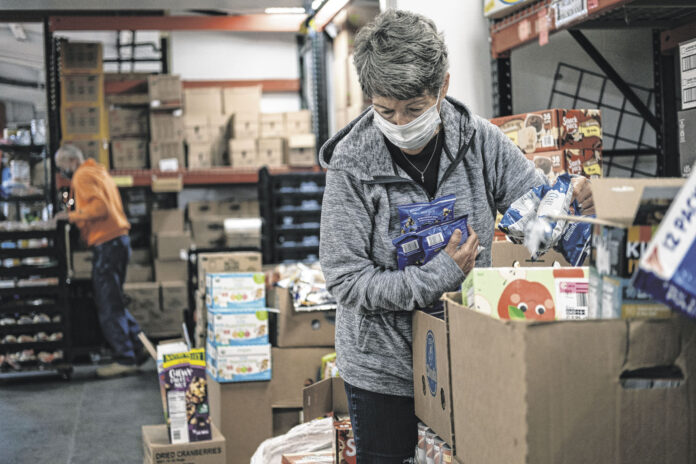
Local officials are expressing concern that more Bartholomew County residents could struggle to pay their utilities this winter with heating bills set to jump and consumer prices projected to remain elevated.
Earlier this month, the federal government said it expects that households in the Midwest could pay upwards of $818 to heat their homes with natural gas from October to March — a 49% increase compared to last winter.
The largest increase is projected for households using propane, which could see a 69% increase — roughly $800 — to $1,805 over the same time period, according to estimates from the U.S. Energy Information Administration.
Those using electricity in the Midwest are expected to see a more modest increase of 5%, to $1,346.
Indiana has some protections against shutoffs during the colder months of the year, including a moratorium that bars utility companies from disconnecting service from Dec. 1 to March 15 for anyone who is eligible for and has applied for the federal Energy Assistance Program.
But the protections don’t erase the obligation to pay for bills that may have accumulated over the winter, which has local officials preparing for a spike in people asking for help once the moratorium ends.
“There will be a wave of folks who need help,” said Kelly Daugherty, executive director of Love Chapel, a local nonprofit that operates a food pantry and provides financial assistance with utility bills, among other services. “What happens is that most of those folks go on the utility moratorium over the winter when they can’t be shut off. In the springtime, that is when we see the huge bills, the result of what happened over the winter. It’s just a vicious cycle.”
Concern about rising heating bills this winter is also mounting at Human Services Inc., particularly as this winter is projected to be slightly colder than last year — meaning that people will be using more energy to heat their homes and likely having to pay more for it.
Human Services Inc. is the service provider in Bartholomew County for several federal programs that aim to help people who are at risk of having their utilities disconnected, including the Energy Assistance Program and Low Income Household Water Assistance Program.
“It’s going to be difficult for our households to be able to make ends meet with a projected increase in their utilities,” said Donna Taylor, executive director of Human Services Inc.
The Energy Assistance Program aims to help people with their heat and electric bills, according to the Indiana Housing and Community Development Authority. The Water Assistance Program helps qualified low-income households with certain water and wastewater bills. Additional help with heating and electric bills is available through the American Rescue Plan Act, Taylor said.
A significant number of local residents would likely meet the income caps for the program, which are currently set at no more than $2,251 per month for a single-person household, $2,944 for a two-person household and $4,329 for a four-person household.
About 1 in 6 households in Bartholomew County reported having less than $25,000 in income over the previous year, or less than $2,083 per month, according to the most recent U.S. Census Bureau estimates.
The forecast from the U.S. Energy Information Administration is the latest reminder of higher inflation ripping across the global economy, The Associated Press reported.
Earlier this month, the federal government released a report showing that prices were 5.4% higher for U.S. consumers in September than a year ago, according to wire reports. That matches the hottest inflation rate since 2008, as a reawakening economy and snarled supply chains push up prices for everything from cars to groceries.
The higher prices hit everyone, with pay raises for most workers so far failing to keep up with inflation, according to the AP. But they hurt low-income households in particular.
The biggest reason for this winter’s higher heating bills is the recent surge in prices for energy commodities after they dropped to multi-year lows in 2020, according to wire reports. Demand has simply grown faster than production as the economy roars back to life after shutdowns caused by the coronavirus.
Natural gas in the United States, for example, has climbed to its highest price since 2014 and is up roughly 90% over the last year, according to the AP. The wholesale price of heating oil, meanwhile, has more than doubled in the last 12 months.
Just over 1 in 5 Americans had to reduce or forgo expenses for basic necessities, such as medicine or food, to pay an energy bill in at least one of the last 12 months, according to a September survey by the U.S. Census Bureau.
Love Chapel, for its part, saw an increase in people needing help with utilities earlier this year but has since leveled off, Daugherty said.
The nonprofit has a program in which it will match utility payments up to a certain amount that are made during the moratorium months, but few people — generally about 10 or fewer — take advantage of it.
“I would love it if we could get a lot more people to do that because it’s a creative way to stretch their dollars and then it lessens the problem in the spring when those utilities come due,” Daugherty said.
But only time will tell how much more expensive utilities will be over the colder months, if at all. If the winter ends up being colder than expected, heating bills could climb higher.
“What that (increase) looks like right now, we don’t know,” Taylor said. “But it is alarming and concerning.”




